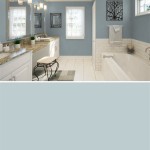Types of Paint for Bathroom
Bathrooms are unique spaces that require specific considerations when choosing paint. High humidity, frequent moisture exposure, and potential for mold growth necessitate paint selections that offer durability, mildew resistance, and easy cleaning. Understanding the different types of paint available and their suitability for bathrooms ensures a long-lasting and aesthetically pleasing finish.
Acrylic Latex Paint
Acrylic latex paint is a popular choice for bathrooms due to its versatility and performance. It dries quickly, offers good adhesion, and is relatively easy to clean. This type of paint is water-based, making it low in volatile organic compounds (VOCs) and environmentally friendly. Acrylic latex paint also exhibits excellent mildew resistance, making it ideal for high-humidity environments. It comes in a wide range of colors and finishes, including flat, eggshell, satin, semi-gloss, and high-gloss, allowing for various aesthetic preferences.
However, acrylic latex paint might not be the best option for areas with constant exposure to water or frequent splashing. While it is mildew-resistant, prolonged water contact can lead to paint damage, especially in areas like showers and tubs.
Epoxy Paint
Epoxy paint is a durable and moisture-resistant choice for bathrooms, particularly for areas that experience constant water exposure. It forms a hard, non-porous surface that is highly resistant to chipping, cracking, and abrasion. Epoxy paint also exhibits excellent chemical resistance, making it suitable for areas exposed to cleaning products and other chemicals commonly found in bathrooms.
While epoxy paint is highly durable, it can be challenging to apply. It requires careful preparation of the surface, including proper cleaning, sanding, and priming. It is also a two-part formula, which requires mixing the resin and hardener before application. Furthermore, epoxy paint can be more expensive than acrylic latex paint.
Oil-Based Paint
Oil-based paint offers excellent durability and moisture resistance, making it suitable for bathrooms. However, it is less popular than acrylic latex paint due to its drawbacks. Oil-based paint contains solvents that emit strong odors and require longer drying times. It is also less environmentally friendly than acrylic latex paint. Additionally, oil-based paint requires the use of mineral spirits for cleanup, which can be messy and harmful to the environment.
Despite these drawbacks, oil-based paint is still a viable option for bathrooms, particularly for areas that require a high level of durability and water resistance. It is often used for trim and doors, where its glossy finish and resistance to moisture are advantageous.
Other Paint Considerations
Beyond the type of paint, other factors should be considered when painting a bathroom.
Finish:
The finish of the paint can affect its appearance and durability. Matte finishes are more forgiving of imperfections but can be more difficult to clean. Glossy finishes are more durable and easier to clean but can highlight imperfections. Semi-gloss finishes offer a balance between durability and a soft sheen.Color:
Light-colored paints can help brighten up a bathroom and create a sense of spaciousness. Darker colors can add drama and sophistication. Consider the overall design of the bathroom and the existing fixtures when choosing a color.
Mold and mildew resistance:
Bathrooms are prone to mold growth, so choose a paint that is specifically formulated to resist mildew. Many paint manufacturers offer mildew-resistant paint options.
VOCs:
Look for low-VOC or VOC-free paints to reduce the impact on air quality and health.
Priming:
Priming the bathroom walls before painting is crucial. This helps to ensure proper paint adhesion, improve coverage, and prevent stains from bleeding through. A primer specifically designed for bathrooms and high-moisture areas is recommended.By carefully considering the different types of paint available and the factors discussed above, homeowners can choose the best paint for their bathroom, ensuring a durable, mildew-resistant, and aesthetically pleasing finish.

What Type Of Paint Should I Use In My Bathroom

Bathroom Paint Guide Choosing The Right Finish

Bathroom Paint Guide Choosing The Right Finish

Solved Finally Learn The Best Types Of Paints To Use In Bathrooms Wallauer S Paint Center

14 Bathroom Paint Colors Ideas And Inspiration Beamin Moore

Which Paint Should I Use In A Bathroom Victorian Plumbing

Best Types Of Paint For Bathrooms Betterdecorating

What Is The Best Paint Type For Bathroom Walls Mgp Painting

How To Choose The Right Bathroom Paint

Bathroom Paint Guide Ideas Advice B Q







